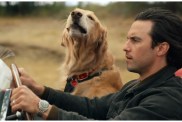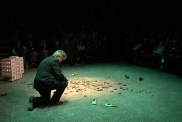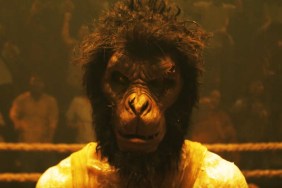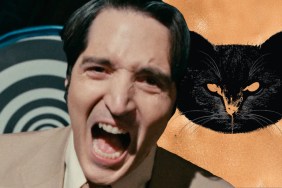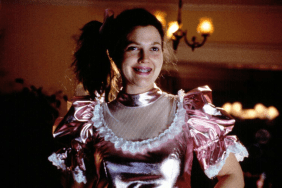Filmmaker Michael Radford has been very well respected in the industry for his diverse and distinctive filmography including the likes of 1984, the Oscar-nominated Il Postino and his adaptation of Shakespeare’s Merchant of Venice starring Al Pacino. His latest film Flawless is somewhat of a departure, being a period crime suspense film set in 1960 London starring Demi Moore as Laura Quinn, an executive at the London Diamond Exchange, who agrees to help the night cleaning man Mr. Hobbs (Michael Caine) steal a small amount of diamonds from the high-security vault, a heist that turns into something much bigger forcing Laura to help her superiors and the authorities recover the stolen jewels.
ComingSoon.net sat down with Radford during a stop through New York to promote the film. He’s clearly as intelligent as his films and though he tends to specialize in serious dramas, he turned out to be a surprisingly jovial and affable interview subject.
(Incidentally, he also mentioned that he’ll eventually be directing the period Chinese film A Dream of Red Mansions, which will now star Renee Zellwegger instead of Kate Hudson, so make sure you credit us on that scoop, Variety!)
ComingSoon.net: Heist films have been a big British tradition for many decades, maybe not so much recently, but why did you decide to take a crack at one of them?
Michael Radford: You know, I take issue with the “heist movie.” Yes, it’s a heist movie because there’s a heist in it, but it’s hardly a heist. With the word “heist”, it makes you feel kind of hi-tech or even Rififi, long sequence. It is and it isn’t. From my point of view, it’s a much older tradition in a way, and for me, a much more interesting one, a suspense movie. A movie in which Hitchcock excelled where the suspense effectively was in the structure of the plot and the way in which the characters interrelated. It was built on character and psychology, rather than just a series of actions and events. I kind of like the kind of cool quality of those films, do you know what I mean? They’re always immensely watchable apart from anything else, and I really wanted to make a watchable movie. It was a movie that came my way. I didn’t write it. I just tried to make something of itrewrote it a bit, but only to give it a bit more
it was a bit mechanical when I first got it, so I just tried to give it a bit more humanity and life and one or two other things. Basically, it’s Edward (Anderson’s) script, and actually, I think it works really well.
CS: Was his script based on any sort of real thing at all or completely fictionalized?
Radford: No, I mean the company was real. They weren’t called “London Diamond,” they were called De Beers, but basically, they controlled the diamond industry and they controlled the economics of the world just about at that time. Honestly, the supply of demands, they could bring countries down, and we didn’t know it at the time. Everybody thought that De Beers was an old-fashioned diamond merchant but didn’t realize how much they were controlling.
CS: But had anyone tried doing anything like this at all, as far you know or had heard?
Radford: No, I don’t think so.
CS: You got a hold of this script through a producer?
Radford: I got it through a producer who sent it to me. Saw “The Merchant of Venice” actually. Why he thought I would do this after “The Merchant of Venice” I have no idea, but he did and he was right! (chuckles)
CS: Did you see what you were talking about in terms of making a suspense movie when you first read it?
Radford: Yes, I did. I liked it, because I thought fundamentally this works. When you get a script, obviously there are things you have to do to itit’s never going to be perfect and your job is to rewrite it and rethink it for actually making it, but it had a basic core of solid, good
basically, it was the hook that got me. For 30 pages of the script I sat there thinking, “How on earth did he manage to do that?” (laughs) I thought, “Well, if I’m thinking that here, the audience is going to be thinking it” so that’s a very good basis to be working on, so let’s work around that and that’s what we did.
CS: And was it always set in the ’60s?
Radford: It was always set in 1960. Why? I have no idea.

CS: Maybe because Demi Moore’s character had to be working in a time where there was rampant sexism against women in the industry?
Radford: Yes, I think definitely and also the whole history of diamonds has completely changed. The diamond industry now is completely different from what it was then, which is why it’s better to set it back then. I mean, this is a caper movie, but it’s a good time to look back at, because of apartheid, the Cold War. It was just a big turning point. It was 1960, which is really the ’50s, and it was the year where things literally swung on their axis. The Sharpeville shootings (in South Africa), Kennedy was elected, the “Lady Chatterley” trial was taking place in the U. K. It was the height of the Cold War, and if you look back now, you’ll see that moment was the moment that things changed.
CS: And you were 14 at the time, so were you aware of all that going on?
Radford: Yeah, you were. Obviously, it’s very interesting making a period movie in a period in which you’ve actually lived. Period is supposed to be from before you were born, and Michael Caine (at that time) was an extra on a TV cop show at that time. So no, I was aware of those things but of course, nobody knew at that period that De Beers had a monopoly of the diamond mines. Nobody knew that. I remember the Sharpeville shootings, and of course, I remember the way that people looked and were because my mother dressed and looked like that. Someone said to me in an interview, “She’s supposed to be this buttoned-up girl. Why she’s wearing red lipstick and nail varnish?” Because that’s what women did.
CS: Did you do a lot of research into the whole diamond trade?
Radford: Oh, yeah. A HUGE amount of research. I went into the diamond business now and then, and it is absolutely fascinating. I mean, it is totally fascinating, the scams that go on, the way which diamonds are traded around the world, and everything. It’s just fascinating. Certainly then it was dominated by this one company. It was really kind of extraordinary. “Blood diamonds” didn’t really exist then–conflict diamonds–at that time, what you meant by “blood diamonds” was produced by the sweat and blood of black labor in Africa. It was later on that they were used to finance conflict.
CS: I was surprised you didn’t show one of Michael Caine’s movies in the theater where they meet.
Radford: Well, you see, I would have done but in 1960, he was still straight out of drama school. It was about 1963 or 1964 when he started to hit the big time.
CS: Michael Caine would seem like an obvious choice for the role because he’s done movies like this before. Was he into doing something like this that looked back at his earlier days?
Radford: Absolutely, yeah, he was, and very sweetly, he said one of the reasons was that he wanted to make a picture with me, which was great. And one of the reasons I did it was to make a picture with him, so that was a mutual thing. He’s just a brilliant actor, just breathtakingly brilliant. He just turns up and it’s so alive what he does.
CS: I’ve met him before and he’s one of these actors that no matter what he says, he keeps your attention, so if you have a good script…
Radford: And you have him there. Obviously, you have to direct him a little bit, but it’s minimal really.
CS: How about Demi? The two of them had worked together years and years before this.
Radford: Yeah, I mean I don’t think that either of them could conjure up the memory much, but they certainly went “Wow!” She was 17 I think when she did “Blame It on Rio” but she was fantastic actually. She was hard-working, she was concentrated, and she put her trust in me, which meant that I could get a really good performance out of her, and I think I have.
CS: She doesn’t do very many movies these days, so she must have liked the script a lot to do it. At what point did someone mention that they had done a movie 25 years before?
Radford: Oh, no, no, no. Demi said it to me the first day we met. Michael was already involved, but the thing was that the schedule was such that he didn’t come onto the picture until the last three weeks. In fact, they only spent five days together, so I was with Demi for about four weeks before Michael came onboard and she was talking about it, saying, “It’s going to be really funny to see him.” There’s only so much you can spend going, “Wow, it’s been 25 years!” (laughs)

CS: Did you do a lot of rehearsals since the movie is so dialogue and character intensive?
Radford: Not really, no. We had a couple of read-throughs. We talked about it, but Michael was making another picture, so he couldn’t come to the read-throughs anyway, but we were very clear what we wanted. As I was shooting it, the one thing that made me think whether this was going to work, was the fact that I spent an inordinate amount of time shooting people talking in offices, thinking “Really? Is this what movies are about? How many more angles can I think of to point the camera at people in an office?” But actually, it really works.
CS: The film is very visually interesting even though there are a lot of dialogue sequences, so how hard is it to keep the audience interested when you have to find ways to shoot these scenes?
Radford: That’s actually I suppose one of the things that I brought to the movie. It’s odd for me to take a script that’s already pretty much there and then go, “How am I going to do this?” I was worried. I haven’t thought of this right from the beginning. What of me is going to be in this movie? But actually, it was all that, how we made it look, how I made the drama work, how to make it visually interesting? That kind of stuff.
CS: You’ve done a lot of period pieces over your career, but this was shot partially in Luxembourg, partially in London? What were the difficulties of trying to recreate this period besides the obvious: cars, costumes, etc?
Radford: We actually shot it almost entirely in Luxembourg. There’s a shot at the Royal Stock Exchange in the city, but that’s all I did really, and I did a couple days in London, and Demi wasn’t there. It was all done with a double, but we had to shoot in Luxembourg for financial reasons, so my challenge was to create period London out of Luxembourg, which is basically a small city and the cars drive on the other side of the road. Nobody notices that the cars have their steering wheels on the wrong side, and I tell you what. If you ever direct an English movie in Luxembourg, here’s the key: put a red telephone box down and anybody is going to think it’s London whatever else is going on. (chuckles)
CS: Was there a lot of sets built on soundstages there?
Radford: No soundstage at all. Most of it was shot in the European Parliament building which was empty at the time.
CS: How did you work with your cinematographer on the look of the movie, because it does have a look of Hitchcock or similar movies from the early ’60s.
Radford: We decided on the look of the movie. We wanted that sort of Technicolor look, very bold primary colors, which basically was the architecture and feel of that area. It was a time when people were experimenting, even in the art world, with bold colors. With Richard Greatrex, the DP, we devised a system of what we called “wraparound lighting” which was a lot of light, because that was the period, a lot of light. You look at Hitchcock movies, they’re shot very often like this with a lot of light, but at the same time, you highlight parts. Normally, when you use high-key lighting, you darken the rest of it to make the key standout, but what we do is we keep everything light but we still put high-key in so you get a keyed light in the middle of a lot of light and it gives it that ’60s feel.
CS: You almost forget you’re watching a color movie at times because it’s so lit up.
Radford: I think we tried to put people into space in an interesting kind of way using the length of the image because it’s shot in Super 35, so you have a wider image. A lot of movies were shot in Cinemascope at that time, but Cinemascope was too difficult to deal with.
CS: What are you doing next?
Radford: Well, I have a couple of movies. I was supposed to be in China making a movie with Renee Zellwegger and Ken Watanabe called “(A Dream of) Red Mansions” but it’s been postponed, and the other movie I was supposed to do straight afterwards–now they’ve crashed into each other–was a Spanish movie, 100% in Spanish, set during the Spanish Civil War, called “La Mula,” “The Mule”, it’s based on a bestselling novel. It’s a very, very funny story about the Spanish Civil War.

CS: You’re obviously comfortable working in different languages and locales. I spoke with Mike Newell who did “Love in the Time of Cholera” and they decided to do it entirely in English, which seemed odd. You’re doing that in its Native language and will cast a lot of Spanish actors for your movie?
Radford: Yeah, I’m doing it in its native language. Actually, I spoke to Laura Bickford recently who produced “Traffic” and she just produced “Che” that Soderbergh’s done with Benicio Del Toro and they did all of that in Spanish language.
CS: You tend to like to move around the world a lot, so what’s the appeal and difficulties in doing that sort of thing?
Radford: You know, I like it, because it adds to the adventure. It’s just fabulous to go to different places and involve yourself, not just in making a movie, but in a whole different culture. It’s really interesting.
CS: Do you tend to bring a lot of your people or do you just work with whatever crews that are there?
Radford: I tend to try to work with the same DP but not necessarily. I had something like 27 different nationalities on the crew of this picture.
CS: Really? You don’t really hear much of Luxembourg in terms of anything, let alone films being made there.
Radford: There’s a tax break there, which is really important and it’s a really rich place because it’s full of banks basically. It’s tiny though, there’s nothing there. It’s just a town and a couple of fields and then you’re back in France. (chuckles) There’s no crew there really. There are a few people who’ve hooked onto the fact that there’s a tax break, so they stay there and they work, but basically, you bring everybody in, but you can bring them in quite quickly from Belgium, France, Germany, it’s kind of right in the center of Europe, lot of Italians, Belgians, French, Poles, a lot of people working, so you just bring in the crews. We’ve actually gotten really used to that in Europe, everybody working together.
CS: Luxembourg must be one of those hidden gems, because you hear about Prague and other Eastern European countries for filming but not there.
Radford: Yeah, a lot of movies have been shot there. I mean, I shot “The Merchant of Venice” there.
CS: Did you really? I just assumed you shot that in Venice.
Radford: I shot some in Venice, but most of it, I shot in Luxembourg.
CS: Because Lasse Hallstrom shot the Heath Ledger movie “Casanova” in Venice.
Radford: Straight after actually. They were just booking the same hotel rooms. As we were checking out, they were checking in.
Flawless opens in New York, Los Angeles and other cities on Friday, March 28, and you can check out an exclusive clip here.
